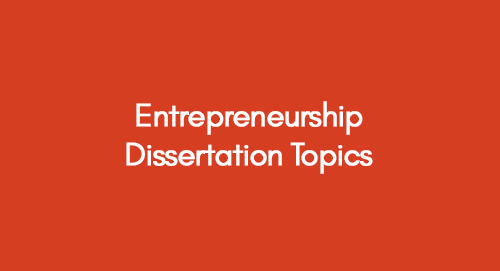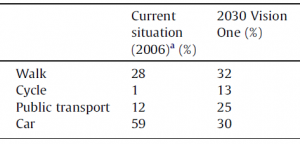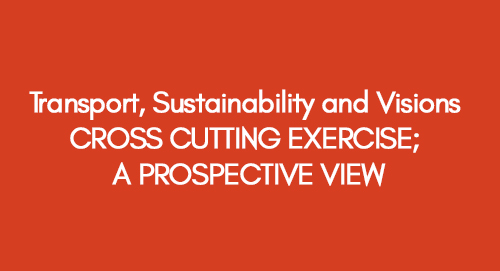
Application of Lean Tools & Techniques in Cigarettes Production – A Literature Review
February 27, 2021
Top 120 Entrepreneurship Dissertation Topics | Free Ideas for 2025
May 27, 2021The foremost strategy for an enhanced sustainable transportation requires consideration of various parameters such as demand/load management, operational control, financial impact, technology enhancements of vehicles, use of alternate and/or clean fuels, smart use of lands and integrated transportation planning. In the last few decades, successful planning and implementation of sustainable transportation has not been too impressive, probably due to the lack of resources and/or motivation amongst the stake holders, and uncertainty over the magnitude of impact (Schiller et al., 2010). .
However, the progress and motivation has changed in the last few years, as various regional planners are now showing interest in active persuasion on these strategies. These agencies have taken a leading role in preparing prospective plans though application of their expertise. In order to achieve sustainable future with respect to transport activities, it is important to develop the methods which can be adopted to achieve the major changes in our activity patterns.
This paper presents detailed analyses on following three projects/reports proposed by various research groups. The visions presented in these reports are intended to review the expectation of transport system models of the future. The primary purpose of this paper is to identify key issues related to transport and sustainability, such as the future behavior of transportation system, its requirements, challenges, expectations and various other key parameters of these three visionary projects.
The Foresight Visions 2030 Project
The vision 2030 final report was published in 2013 by a group organization with a transport vision, in association with local highway authority of the UK. The report provided comprehensive investigations into the opportunities as well challenges in the long term strategy for highway network. The primary aim of the report is to outline and present the 2030 vision of the possible mobility/transport requirements, and consequently identify the strategic highways activities that must be performed to be able to work towards the suitable vision of 2013.
Apart from shedding light on the futures scenarios and transport vision, the report also discusses the drivers for change along with concepts of how to initiate working with the visions, in order to develop strategies that can be adapted to achieve these visions.
The vision developed in the 2030 project investigation undertakes scenario planning while considering the multiple trends of factors, hence imagining multiple futures. Thus, three alternate socio economic versions of scenarios were presented, each of which is associated with a separate vision of future transport network. These visions include “The Global Economy”, an approach driven by market, “Sustainable Life Style”, driven by community based life style, and “Control and Plan”, which is driven through enhanced regulation movements. The PESTEL analyses were completed in the scenarios, and 12 transport visions/elements were presented in this report, including concepts such as The Green Highway, Zero Accidents, The Connected Customer and Freight Foremost etc.
“The Green Highway” vision presented the future with highways developed through us highly sustainable materials while following optimum management techniques for operations such as enhanced customer connection. It has been proposed that through adaptation of progressively sustainable practices, for example use of green materials, efficient utilization of resources, smarter designs and increased safety, will lead to an efficient and intelligent transport system. The proposed future of Highways is much more acceptable to what we have today, as it is a sustainably engineered product that is leaner on nature in terms of the cost of finances and environment. The Green Highway concept does seem to be an appropriate representation of the possible sustainable future (Vision 2030, 2003).
The visions of the World Business Council on Sustainable Development
The World Business Council for Sustainable Development (WBCSD) presented the Vision 2050 project with aim to outline a new agenda for business as well as transport structure in the decades to come. The vision idealizes the sustainable world of 2050, showcasing the pathway leading to this development world in terms of the fundamental changes required in the governance structure, business behavior, economic framework and in the current transportation system model.
The report was prepared through cooperation of various companies, representatives of businesses, civil society, government, regional partners and various other experts. The report aimed to answer fundamental questions such: how the world would look like in 2050? Can we imagine the sustainable practices of the future world? How can we ensure that sufficient practical are followed in order to ensure smooth transformation to that sustainable world?
The report looks into 2050 by estimating the population of the earth at that time, and visualizing how it would be possible to successfully accommodate billions of additional people without damaging the eco system, biodiversity and climate of the planet earth, while sustaining the life within the available natural resources. The report further provides a structured path incorporating the initial steps that must be taken in order to achieve the scenario, proposal of the next ten years, the fundamental transformations points along with other dimensions, such as for the vision of mobility structure of 2050.
According to this vision, the life after a few decades will be radically different and highly sustainable. According the vision presented, “Universal access to safe and low-impact mobility” will be available to all, and the social as well as economic activities will increase. The amounts of users will double, however the system will be influenced by the emergence of state of the art technologies. The mobility management will be able to almost eliminate the deaths in involved in transportation system, while the environmental concerns will reduce considerably through development of sustainable practices such as; vehicle efficiency improvements and utilization of alternate fuel sources. According to the vision 2050, this sustainable transport mechanism will evolve through development of highly efficient electric vehicles, use of lighter materials in their production, advanced aerodynamics, use of low carbon fuel sources and application of influential policies which will emerge though effective cooperation between the key stake holders. This vision foresees that the efficiency, reliability, comfort and speed for both public and private transport system of 2050 will become highly efficient due the progression of an intelligent transportation system (IST) (Vision 2050, 2010).
The Visions for Walking and Cycling in 2030 project
There is not much doubt over the fact that cycling and walking are the most sustainable methods for travelling. They can effectively contribute in the sustainable transport goals, sustainable community development as well as in traffic and pollution reduction. Although there has been many initiatives taken by the local authorities to promote cycling and walking, there is a need of a long term consistent strategy that can be followed to the sustainable goals of the future.
The paper presents a set of three alternate visions describing the role of cycling and walking in the year 2030. All of these visions illustrate a desirable cycling and walking oriented system of transportation based in UK. Each of the vision expects a substantial change in the overall transportation system as compared to the current system, as the society is expected to move towards a system where sustainable methods of transport are considered to be much more important.
One of the visions presented in the paper is the “European Best Practice”. The vision showcases an extensive implementation of best practices towards an optimum behavior of travel. The modular break up of this vision has been given in the bale below;
Table 1; approximate mode-split; comparison of 2006 with 2030 European Best Practice (Source: Tight, et al., 2006)

As it can be observed from the table above, the vision foresees a considerable increase in cycling, and a moderate increase in walking. The vision proposes that the use of public transport would increase while the use of cars in urban areas will decline due serious constraints regarding energy usage The most obvious change that this vision foresees is that application of best practices, supporting measures and infrastructure enhancements will make cycling and walking much more attractive and popular in the community, attracting a wider range of people. Safer bicycle paths along additional routes will be developed and pedestrian walkways will be made more pleasant, while developments in smart technologies will enable walking and cycling to become the predominant modes of urban transport (Tight et al, 2011).
Results and Discussion
In order to further analyze the dimensions of sustainability, it important to shed light on the objectives of the modern world, and review the direction of the human practices; where are our practices leading to?
There is a growing realization that the decision made by the humans of today’s era is going to have a considerable influence on the environment of the future individuals; our next generations. It is true that this decision may not have an impact in short time scale, but in longer terms, the pattern of life/procedures/activities that we follow today will have a consequential impact in years to come (He and Zhang, 2011). This signifies the argument that we must look ahead and follow strategies that can ensure a better and sustainable future.
The increase in the environmental disorder and congestion, limited resources of fuel and other financial factors are consistently putting pressure on the society and freight industry. This pressure is not going to decrease unless or until the directions of the future developments are shifted towards the sustainability models. Thus the strategic implications will have to be adopted in today’s world where the growing realization of higher rates of CO2 discharges has raised air quality and resource utilizations.
The primary objective of all the three projects reviewed in this research is to work towards sustainable structures where environmental concerns can be reduced in the transportation system. The world we inhabit is in need to address the key transport problems though implicating;
- Reduction of congestion, air contamination and wastage of valuable resources
- Reduction of release of CO2, hence reducing global warming and prevention of climate change
- Avoid damage to nature through use renewable/recyclable materials, and lesser use of fuels etc
- Enhanced and efficient energy utilization, better health and safety and implementation of mitigation measures
- Optimum resource planning
The current transport system has been unable to address these complicated problems as yet. There is a storm of hardships in satisfying the investors/stake holders as only some of them have the ability to lead while making resources and economy involved into their advantage. Every crisis presents an opportunity, therefore it is an opportunity to do things you think you could not do before through commitment, control and challenge.
With the growing challenges of the world, it is important to address these crisis or obstacles in favor of the increasing population. There is a perception that approximately 9 billion people will be living in this planet by the year 2050. It is extremely critical that we use all energies to engineer a framework of prosperity by discovering advanced technologies and sustainable practices.
All the three projects provide the opportunity to break the unfeasible model of demanding consumptions, and substituting it with a model based on stable use of renewable resources, effective management and implementation of smart techniques. The way to this green world is to bring drastic and extensive change in the techniques and procedure we follow today (Banister, 2005).
The 2030 Vision Analyses
Various ideas in terms of plans and possible strategies were formulated through the 2030 vision scenarios. The primary objective of all the ideas was to imagine the future concepts of transport which can present a new starting point for the prospective development of UK highway authority. Interestingly, although the three scenarios were different in their own way, some of the concepts derived from them had a considerable degree of convergence in certain aspects.
The 2030 vision provided an encouraging and out of the box thought process that can be utilized by the Highway authority to consider while planning for any development works. The driving force indentifies in the research can be implemented with commitment and ownership, but the objectives have to be very clear for the stake holders to actually apply the proposed techniques in the prospective plans. Therefore, it important to prioritize all the activities associated with the visual presentation of the future, with a long term focus of accommodating the client focused environment.
The visions outlined in the project are feasible considering the current transport trends and global issues; the traffic on roads is expected to grow by more than half in the year 2031 (National Road Traffic Forecast). The overall journey times will substantially increase due to congestions. Therefore an enhanced capacity of road networks with improvements in quality will have to be provided for ensuring success of the transport system.
However, in order to successfully imply the changes recommended in the visions, the stake holders will have to take set targets for the short as well as long term deliverables. Special consideration will have to be given to the issues/works which can be directly resolved by the highway authority, while ensuring to address the any issues that come along.
WBCSD Vision Analyses
The vision 2050 is primarily based on a business strategy that is far closer and grabbed by the civil society and the government than ever before. Calculated and sorted answers of fundamental questions have been discussed, such as who clarify the incentives and systems? How will success be defined? Who finances the transition processes research and development, and promotes technology advancement, for example in the future mobility model? Who will or should be the first mover in various activities?
Research shows that for the decent survival and progress of mankind through twenty first century requires a complex design and framework of strategies involving finance, transport, cities, food, energy and forest. Unwanted crises and challenges has asked many questions to individuals and governments to make alterations, re-evaluate priorities, and lead to motivating new experiences and directions in growth. In the past few decades there has been a growing regard in the management of crises and the use of anticipating models that have influenced social, economic as well as transport policy change.
The feasibility and success of the subject vision is not only dependant on business sector, as the prosperity will also demand consistent efforts in the coming decade from various stake holders, such as highway authority, and sectors of civil society. According to the vision 2050 of mobility, a holistic approach will be undertaken which improves the integrated transportation system. An integrated methodology of planning will be implemented, while IST will play its role in connecting the vehicles with infrastructure. Higher levels investments can of course address the growth of passenger as well as freight transports. The consumer desire of an eco-friendly system and provision of real time information will lead to adaptation of a sustainable mode of transport, which will consequently reduce the carbon emission. Implementation of polices related to mobility can lead to innovative production methods of fuel, such as bio fuels, hybrid, electric and hydrogen bases production. The rails networks can be diversified and higher levels of shipping can also be achieved through adaptation of an enhanced transport chain performance. The traffic on roads will also become safe as the road deaths will be reduces to zero via implementation of safety technologies/measures in vehicles and advancement in infrastructure.
These visionary analyses provides the “must haves” of 2050 transportation systems while considering various approaches, policies and growing realization of sustainable practices amongst the users. Although the report is aimed at the sustainable business structures of the 2050, the mobility structure visualized in this report sets standards for a global effort in harmonizing the best practices that can lead to a very acceptable global future. This vision of a sustainable mobility model seems to be highly effective and feasible as it based on the practices that have already been mobilized in the current world. However, the potential barriers will have to be resolved by completing comprehensive opportunity analysis/assessments, and postponing the course of action will only bring more hardships in achieving the targets.
Walking and Cycling 2030 Vision Analyses
The vision of 2030 brings about substantial change levels of walking and cycling especially in the reasonable urban areas. Contains elements/scenes we are familiar with and which are important for walking/cycling. The research focuses 5 distinct locations, while reviewing standard trips in-between these locations. The report provides three alternate visions as discussed previously, and highlights the current status of the cycling and walking, while aiming to develop understanding on how various groups will respond these visions.
The research completed and the discussion followed can help to promote the thinking process of the desirable pedestrian and cycling friendly future, as there is no doubt that this proposed culture is desirable as well as sustainable. The expected benefits of this enhanced trend in cycling and walking would definitely lead to a considerable reduction in noise pollutions, congestion and greenhouse gas emissions etc.
Furthermore, the safety of the users is expected to improve, as well as the fitness of the population would also improve due the physical nature of this transportation system. Following the footsteps of this vision can also lead to a broader socio economic benefits such as the overall quality of environment of the urban areas will improve; the children will have an easy access to their environment and the financial load of transport, health etc will reduce on the society.
The social context provided in the vision is quite similar to the present day, and it has similar methodology of adoption which has already been party applied in some of the European urban areas, hence it has to be considered as highly feasible. This goes on to show that implication of the vision is highly likely in the world of developing sustainable practices. However, it is difficult to predict whether the recommendation, or pathway presented in this vision can be easily achieved.
It also important to realize that most of the measure included in the vision are primarily localized to neighborhood (for example the development in the pathways), therefore it implication of these measures are not expected to bring about many additional problems. Major cities such as London might face higher level difficulties in terms of development of network and other connectivity features, especially in cases of long travel distances within the city.
In order to achieve this vision, more research will have to be completed with specific focus on the path which the current establishment can follow to move towards the 2030 alternate vision. The local authorities will have to play their part via working with the transport stake holders and other key influential groups/representatives of the civil society; to attempt exploring the types of changes which can be easily adopted in the correct transport structure, and look ahead to map-out the possible alteration which can be adopted in the near future. The goal is to achieve a complete sustainable system of transportation, and walking and cycling are definitely expected to play a major role in achieving this target.
Recommendations: In order to reduce the greenhouse gas emissions over the next few decades, regulation have been set by the UK authorities to limit the emissions from various industries (CCC, 2010). However any such regulations or targets have not been officially announced and it may be a good idea to work on the presentation of similar kinds of regulation on the transport system, so that all the stake holders are obliged to work on the pathways defined in these projects in order to achieve certain achievable sustainable targets.
References
- Adams, J., (2000). Hypermobility. Prospect.
- Banister, D., (2005). Unsustainable Transport: The Transport Crisis (Transport, Development and Sustainability Series). Taylor and Francis.
- CCC, (2010). The Fourth Carbon Budget: Reducing emissions through the 2020s. The Committee on Climate Change, London
- Dennis, K. and Urry, J., (2009). After the car. Cambridge, Polity Press.
Urry, J., (2007). Mobilities. Cambridge, Polity Press. - He, X., and Zhang, K. (2011). Multidisciplinary approaches to new pathways to sustainable development. Environment and development, 1(1), 1-7.
- Hensher D.A. and Button K.J., (2003). Handbook of transport and the environment (ed). Elsevier, Oxford.
- Loe, E. (2000). The Value of Architecture: Context & Current Thinking. London: RIBA Publications
- Nakamura, H., Hayashi, Y. and May, A.D., (2004). Urban transport and the environment – an international perspective. Elsevier.
- Ryley, T. and Chapman, L., (2012). Transport and Climate Change. Emerald publishing group.
- Schiller, P.L., Bruun, E.C. and Kenworthy, J.R., (2010). An introduction to sustainable transportation – policy, planning and implementation. Earthscan.
- Sperling, D. and Cannon, J.S., (2007). Driving climate change: cutting Carbon from transportation. Elsevier.
- Tang, K., (2009). Green CITYnomics – the urban war against climate change. Greenleaf publishing.
- TEP, (2005). Advancing the delivery of green infrastructure: targeting issues
- Tight, M. et al, (2011). Visions for a walking and cycling focussed urban transport system.
- United Nations, (2002). Plan of Implementation of the World Summit on Sustainable Development. Resulting plan from the World Summit on Sustainable Development
- Vision 2050, (2010). The new agenda for business, World Business Council for Sustainable Development (WBCSD)
- Vision 2030, (2003). An investigation into the long-term challenges and opportunities for the UK s strategic highway network
Get 3+ Free Dissertation Topics within 24 hours?

























